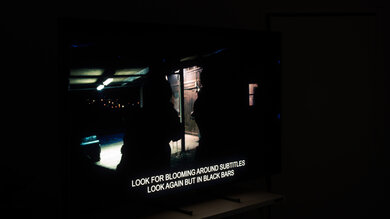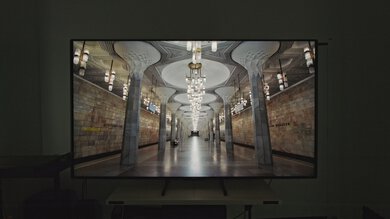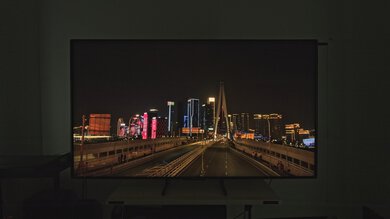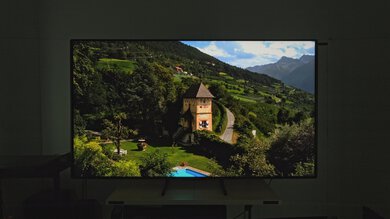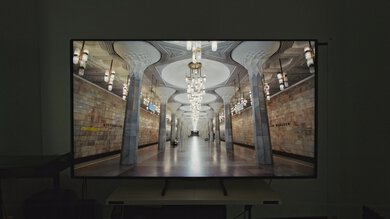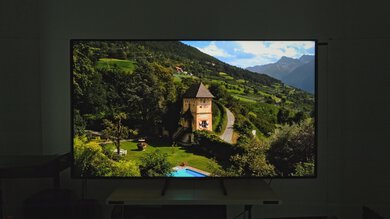The Hisense UX is Hisense's highest-end TV in 2023, and it sits above the Hisense U8/U8K in the company's ULED lineup. It's a limited release and, in some ways, is the unofficial successor to Hisense's previous experimental high-end TV, 2021's Hisense U9DG. The UX is only available in an 85-inch size in North America and is packed with cutting-edge technology. It has over 20,000 Mini-LEDs with 5000 local dimming zones and is advertised to hit 2500 nits peak brightness in HDR, with a 150000:1 contrast ratio. The TV's display uses a quantum dot layer alongside an anti-glare screen and an ultra-wide viewing angle filter. Like other Hisense TVs, the UX supports both Dolby Vision and HDR10+, is certified as IMAX Enhanced, and is Dolby Atmos compatible. For gamers, the TV is fully featured: it's advertised as being capable of Dolby Vision gaming at 120Hz, it has two HDMI 2.1 bandwidth ports that can do up to 4k @ 120Hz with variable refresh rate support, and comes with Hisense's Game Mode Pro. Finally, it has the user-friendly Google TV interface, which is easy to use, and has a great selection of streaming apps.
Our Verdict
The Hisense UX is an excellent TV for mixed usage. It's extremely bright in both HDR and SDR, with fantastic reflection handling, making it a stellar choice for any bright room setting. Its contrast and black uniformity are extraordinary, so HDR games and movies look amazing in dark rooms. It has very good image processing and supports advanced Dolby and DTS audio formats, as well as both Dolby Vision HDR and HDR10+, making it a great choice for a home entertainment TV. It's great as a gaming TV due to its amazing picture quality, superbly low input lag, and good response time, although its input lag isn't as low as some other competing models.
- Extraordinary contrast results in deep blacks in a dark room.
- Fantastic reflection handling.
The Hisense UX is great for TV shows. It gets extremely bright in SDR and has fantastic reflection handling, so it's a great fit for bright rooms. It has good image processing, so low-bitrate shows from streaming platforms look good, as does low-resolution content from cable boxes and DVDs. Its viewing angle is decent, especially for an LED TV, making it a good choice for a wide seating arrangement.
- Fantastic reflection handling.
- Very good image processing.
- Decently wide viewing angle.
The Hisense UX is a great TV to watch sports on. It gets extremely bright in SDR and has fantastic reflection handling, easily handling the brightest rooms. Its response time is excellent, leading to minimal blur when watching fast-moving sports. Its gray uniformity is decent, but in some sports with large areas of bright color, the sides of the screen are noticeably darker than the center. Its viewing angle is surprisingly decent for an LED TV, so it's a good choice if you want to watch the game with friends in a wide seating arrangement.
- Fantastic reflection handling.
- Amazing response time.
- Decently wide viewing angle.
- Some noticeable vignetting on large areas of bright color.
The Hisense UX is an amazing TV to play games on. Its contrast and dark details look fantastic in Game Mode. It gets extremely bright in SDR and has fantastic reflection handling, so it looks great in even the brightest game rooms. Its input lag is very low, so your inputs are translated to the on-screen action very quickly, but it's higher than on some other competing models. Its response time is excellent, leading to minimal blur when playing action titles.
- Fantastic reflection handling.
- Very low input lag.
- Amazing response time.
- Very good image processing.
- Great selection of gaming features.
The Hisense UX is a very good TV to watch the latest movies on. It has an extraordinary contrast ratio, with nearly perfect black uniformity, so it looks truly outstanding in a dark room. Its HDR brightness is exceptional, so highlights pop next to the TV's very deep blacks. Unfortunately, the TV's color accuracy is only decent without being professionally calibrated; it's certainly not bad and is good enough for most, but you'll need to invest in calibration if you care about color accuracy. Thankfully, the TV's image processing is very good, as it upscales content from DVDs well, and low-bitrate content from streaming platforms is mostly free from unsightly compression artifacts.
- Extraordinary contrast results in deep blacks in a dark room.
- Nearly perfect black uniformity.
- Very good image processing.
- Fantastic color gamut and color volume.
- Sub-par HDR native gradient handling.
- Noticeable stutter in low framerate content.
The Hisense UX is an amazing TV for playing the latest HDR games. The TV looks vibrant and colorful in Game Mode. It has an extraordinary contrast ratio and nearly perfect black uniformity, so the TV looks amazing in a dark room. It gets extremely bright in HDR and has fantastic reflection handling, so it looks amazing even in bright rooms. Its input lag is very low, so your inputs feel quick and responsive, although it's higher than on other competing models. Fortunately, the TV's response time is amazing, so there's minimal blur in fast-moving HDR games.
- Extraordinary contrast results in deep blacks in a dark room.
- Very low input lag.
- Amazing response time.
- Great selection of gaming features.
- Fantastic color gamut and color volume.
The Hisense UX is an amazing TV to use as a PC monitor. It gets extremely bright in SDR and has fantastic reflection handling, so it easily handles bright offices. It has very low input lag, so your mouse movements are quick and responsive, although it's higher than other competing TVs and certainly higher than on monitors. Its response time is excellent; there's minimal blur when things start moving quickly, like when playing action games or moving windows around. The TV also has a decent viewing angle, so the TV's sides won't look too washed out when you sit close to it.
- Very low input lag.
- Amazing response time.
- Decently wide viewing angle.
Changelog
- Updated Jan 23, 2025:
We mentioned the newly reviewed Hisense U9N in the PQ EOTF Tracking section of this review.
- Updated Nov 12, 2024:
Clarified that our results aren't valid for the European models and the 2024 models in the Differences Between Sizes And Variants section.
- Updated Nov 08, 2023: Verified that the TV can't do Dolby Vision gaming at 120Hz even though it is advertised to be capable of it, and updated the Introduction and Xbox Series X|S Compatibility text boxes accordingly.
- Updated Nov 08, 2023: Review published.
Check Price
Differences Between Sizes And Variants
We tested the 85-inch Hisense UX released in 2023, and it's the only model available in North America. It's a limited release and isn't as widely available as Hisense's other models. There is a European variant of this TV, the Hisense UXKQ, which is available in more sizes. It has comparable specs to the North American variant, but it advertises a higher 144Hz refresh rate and uses the Vidaa smart platform instead of Google TV, so our results aren't valid for it.
Hisense released an updated version of this model in 2024 with the exact same model name. It comes in a 98-inch and a 110-inch model. It performs differently than the 2023 version, so our results aren't valid for it. It can be hard to determine the model year since Hisense kept the same model number. However, the 2023 version was a limited release that's mostly sold out everywhere and was only released in an 85-inch model, so if you find the 98-inch or 110-inch UX in stock, it's the 2024 version.
| Size | US Model | European Model |
|---|---|---|
| 55" | 55UXKQ | |
| 65" | 65UXKQ | |
| 75" | 75UXKQ | |
| 85" | 85UX | 85UXKQ |
Our unit was manufactured in March 2023, and you can see the label here.
Popular TV Comparisons
The Hisense UX is a limited, super high-end release from Hisense, and as such, it's an extremely high performer. It's better than most competing products due to its extremely high peak brightness, super deep contrast, and very good local dimming, but it's also more expensive overall. For most consumers, cheaper high-end LEDs like the Hisense U8/U8K, TCL QM8/QM850G QLED, or even the Sony X93L/X93CL represent much better value. For about the same price as the Hisense UX, you can also get the slightly better Sony X95L, although the Hisense certainly pops more than the Sony when side-by-side, with the Sony having the edge in image processing.
See our recommendations for the best TVs for watching movies, the best smart TVs, and the best 80-83-85 inch TVs.
The Hisense U8K and Hisense UX are very similar TVs, with the Hisense UX being just a bit better overall. The UX gets brighter, has better contrast, and has a higher response time than the U8K. The UX also has a significantly wider viewing angle, making it much better for wide seating arrangements. The U8K, however, has lower input lag, better HDR gradient handling, and is much more color-accurate before calibration. The U8K is also capable of up to 4k @ 144Hz on its two HDMI 2.1 bandwidth ports, while the UX is limited to 120Hz.
The 2023 Hisense UX and Hisense U9N are very similar. The UX's contrast is a bit deeper, and it gets a bit brighter in HDR and SDR, but the U9N is the more accurate of the two TVs. The U9N is the better TV for gaming due to its lack of VRR issues, its faster 144Hz maximum refresh rate, and its slightly lower input lag. It's also capable of Dolby Vision gaming at 120Hz, while the UX is limited to 60Hz.
The Sony X95L and the Hisense UX are two extremely high-end TVs, with the Sony being a bit better overall. The Sony is the more accurate TV of the two, not requiring to be calibrated to look its best. It also has better image processing than the Hisense, especially regarding HDR gradient handling. Finally, the Sony is more predictable, with fewer quirks than the Hisense. Still, the Hisense is significantly brighter, with better local dimming, and is the slightly more colorful TV, so it certainly pops more when both TVs are side-by-side.
The TCL QM850G and the Hisense UX are both flagship TVs from their respective manufacturers, with the Hisense having the edge over the TCL. The Hisense has better contrast, helped by slightly better local dimming. It also gets brighter than the already extremely bright TCL and has a much wider viewing angle. Finally, it has much better image processing overall. The TCL does have slightly lower input lag and much better HDR gradient handling, as well as a higher 144Hz refresh rate on one of its HDMI ports.
Test Results

The Hisense UX has a premium design, if a bit thick for a high-end TV. Still, most TVs are much thicker at their center point, while this TV is uniformly thick throughout. It has a unique look with angled side speakers and visible screws on the back. The TV has slim adjustable feet that feel sturdy and don't take up much space.
The TV comes with a pair of adjustable feet that support the TV well. They're very thin, made of metal, and have minimal front-to-back wobble.
Footprint of the 85-inch stand in the wide position: 67.9" x 17.7". In the narrow position, the 85-inch stand has a footprint of 18.3" x 12.6". The feet lift the TV about 3.2" above the table, so most soundbars fit in front without blocking the screen, although they won't fit between the feet when they're set in the narrow position.
The back of the TV is made of plastic, with two different textured patterns: vertical lines in its center plate and horizontal lines on the side panels. There's a built-in subwoofer on the back of the TV near the center. Unfortunately, the TV doesn't have clips for cable management, so cables just dangle from its sides. The inputs are recessed on the left-hand side of the TV when facing the front, and they're hard to access when the TV is mounted flat against the wall.
The TV has good build quality. The TV is solid and looks and feels well-built. It's mainly made of hard plastic, with metal feet and borders. There's a bit of front and back wobble, but the feet support the TV well overall. There are no obvious quality control issues with our unit. Unfortunately, there's a large amount of flex on the two plastic panels next to the TV's inputs; it's not worrying, but it's an excessive amount of flex on what is otherwise a premium product.
The TV's contrast is fantastic. Its black levels with local dimming are so low that they go beyond the limits of our LS-100 meter; still, the 404200:1 contrast ratio above is a bit on the high side, as Hisense advertises the TV as having a 150000:1 contrast ratio. Either way, this TV has extremely deep blacks, some of the best we've seen on an LED TV, so it looks amazing in a dark room.
Overall, the TV's processing keeps up very well with fast-moving objects, and lighting zone transitions aren't very noticeable, with minimal haloing. Still, small bright objects get so dim with rapid movement that they almost disappear, which is disappointing on a TV with this many dimming zones.
The TV's HDR peak brightness is fantastic. Even though the TV's brightness is significantly dimmer in large bright scenes, it's still easily bright enough to overcome any number of lights. Highlights are extremely bright and stand out very well.
These measurements are after calibrating the HDR white point with the following settings:
- HDR Picture Mode: HDR Theater
- Brightness: 100
- Gamma: ST2084
- Local Dimming: High
- Color Temperature: Warm 1
- Dynamic Tone Mapping: Off
We also tested the TV with Dynamic Tone Mapping enabled. Here are the real scene results:
- Hallway Lights: 1042 cd/m²
- Yellow Skyscraper: 886.5 cd/m²
- Landscape Pool: 377 cd/m²
The TV's HDR brightness in Game Mode is fantastic. There's no noticeable difference in peak brightness from 'HDR Theater' mode.
These measurements are after calibrating the HDR white point, with the following settings:
- HDR Picture Mode: HDR Game
- Brightness: 100
- Gamma: ST2084
- Local Dimming: High
- Color Temperature: Warm 1
- Dynamic Tone Mapping: Off
The TV has decent PQ EOTF tracking, but all scenes appear brighter than the content creator intended. The TV hard clips when it reaches its peak brightness, leading to a loss of bright detail. The TV appears to be gaming some test patterns, as its EOTF tracking is much better with a 10% window size, as seen here. If you care about PQ EOTF tracking, consider the similar but more accurate Hisense U9N instead.
The Hisense UX's SDR brightness is fantastic, so glare isn't an issue even in the brightest rooms. The TV's Automatic Brightness Limiter (ABL) does dim the TV significantly when bright highlights take up a significant portion of the screen, but they're still very bright.
These measurements are after calibration with the following settings:
- Picture Mode: Theater Night
- Brightness: 100
- Local Dimming: High
- Color Temperature: Warm 1
- Gamma: 2.2
- Active Contrast: Off
The Hisense ULED X has a fantastic HDR color gamut. It has almost complete coverage of the commonly used DCI-P3 color space, with stellar tone mapping. Some colors notably deviate from what they should be, however; most notably magentas, and reds to a smaller degree. The TV also has great coverage of the wider Rec. 2020 color space, although it struggles with saturated greens and blues, and now most colors deviate from what they should be: reds, magentas, greens, and cyans.
The TV's color volume in HDR is fantastic, helped by the TV's extremely high peak brightness and splendid contrast ratio. It displays colors well across all luminance levels, and colors are bright and vibrant, displaying dark, saturated colors well.
The Hisense UX has decent pre-calibration accuracy in SDR. Still, it's not nearly as good as its siblings, the Hisense U8/U8K and Hisense U7K. Its white balance has a decent amount of accuracy errors, leaning too blue overall. Similarly, color accuracy is decent overall, but there are small accuracy errors in most color gradients. The TV's gamma is good overall but is a bit darker than our 2.2 target for a moderately lit room.
The Hisense 85UX has incredible accuracy after calibration, but like other recent Hisense TVs, it's slightly tricky to calibrate. Here, like on the Hisense U6/U6K, calibration points affect the points above them; 50 adjusts 55, 55 adjusts 60, etc.
You can see our full calibration settings here.
The Hisense UX has a decent viewing angle. The image remains consistent at a moderate angle, but if you move too far off-center, colors fade, and the screen looks washed out. Still, it's good enough for a moderately wide seating arrangement, as you can move around the room without the image degrading.
The TV's reflection handling is fantastic. Its glossy finish reduces the impact of reflections enough that this TV can easily handle even very bright rooms. Unfortunately, the TV's finish also introduces rainbow smear when hit by glare from bright lights, which is distracting if you're sensitive to it.
The Hisense UX has sub-par HDR gradient handling. There's very noticeable banding in bright grays, greens, and blues and noticeable banding in every other color gradient except dark greens and blues. Thankfully, the TV's gradient smoothing feature does a good job of cleaning up the TV's banding.
The Hisense 85UX has good upscaling capabilities. The resulting image looks sharp overall, with some, but not excessive, blurring. Fine details are preserved well, and text is easy to read.
Sharpness processing was calibrated for low-resolution or low-bitrate content, with no over-sharpening, with the following setting:
- Sharpness: 10
The Hisense UX uses a BGR (blue-green-red) subpixel layout. For multimedia usage, this doesn't cause any issues, but it causes text clarity issues when you use this TV as a PC monitor. There are easy workarounds for these issues, however, and you can read about them here.
Like the Hisense U8/U8K and Hisense U7K, the TV's response time tuning is different when the TV's refresh rate is below and above 100Hz, as seen here. It doesn't cause any issues when running at a fixed refresh rate, but with VRR enabled, the TV's response time behavior rapidly changes as the TV's refresh rate hovers around 100Hz, which is very noticeable.
The Hisense 85UX has an optional backlight strobing feature, commonly known as black frame insertion. This feature is meant to reduce persistence blur and improve the appearance of motion. It works well at both 60Hz and 120Hz, leading to a sharp image at the cost of some image duplication.
The TV's excellent response time results in a passable stutter performance. Still, there's noticeable stutter in slow-panning shots in 24p content, like movies.
The TV automatically removes judder from any source, ensuring a smooth movie-watching experience.
The Hisense UX supports all three variable refresh rate (VRR) technologies, and its VRR range caps out at 120Hz. When the TV is connected to a PC using an AMD graphics card, it disables HDR when the FreeSync toggle is enabled in the TV's Game Settings menu. For VRR and HDR to work simultaneously, FreeSync needs to be disabled on the TV, although this disables VRR for sources that only use FreeSync for VRR, like older AMD graphic cards.
The Hisense UX has superbly low input lag, but it's higher than most other competing products, including Hisense's other models, the Hisense U8/U8K, Hisense U7K, and even Hisense U6/U6K. It's certainly low enough for all but the most competitive of gamers, but it's disappointing for a premium product like this one.
The TV supports up to 4k @ 120Hz on HDMI ports 3 and 4.
The TV supports chroma 4:4:4 at 4k @ 120Hz with Game Mode enabled, so you can simultaneously have the sharpest text and lowest input lag, although you also need to have the Text Clarity Optimizer enabled.
The TV can nearly take full advantage of the Xbox Series X|S consoles, with 4k @ 120Hz support on HDMI ports 3 and 4, as well as variable refresh rate (VRR) support with both AMD FreeSync and HDMI Forum VRR. Unfortunately, while the TV is advertised as being capable of Dolby Vision gaming at 120Hz, games simply refuse to launch in Dolby Vision mode at that refresh rate, so you have to be in 4k @ 60Hz for it to work correctly.
The TV has HDMI 2.1 bandwidth on HDMI ports 3 and 4, with both supporting up to 4k @ 120Hz. Unfortunately, HDMI 3 is the eARC port, so you lose one HDMI 2.1 port when you plug a soundbar into the TV. It has an ATSC 3.0 TV tuner, so it streams 4k content over-the-air.
The TV supports eARC and can pass advanced DTS and Dolby formats from a connected source to your soundbar or sound system without reducing audio quality. Unfortunately, it doesn't correctly pass through 7.1 sound through LPCM, as the sound only comes out of two speakers.
The TV has a decent frequency response. Like on almost all TVs, there's very little bass. The TV gets extremely loud, but there are many compression artifacts at max volume. Still, the TV is extremely well-balanced at moderate volume, so dialogue is very clear.
This TV has mediocre distortion performance. There's audible total harmonic distortion, especially at max volume, but thankfully, it's significantly less noticeable at moderate volume.
Unlike the Hisense U8/U8K and Hisense U7K, but like the Hisense U6/U6K, the Hisense UX uses version 11 of Google's popular Google TV OS. It's relatively easy to use and especially fast and smooth, with a large selection of apps.
The TV comes with a great remote. Like most modern remotes, it lacks a numpad, and there are quick-access buttons to popular streaming services. The remote has a built-in mic, and so does the TV for hands-free voice control, giving you access to Google Assistant and Alexa. You can ask the TV to search for content, open apps, ask for the time or the weather, and switch inputs.
There's a button underneath the center of the TV to turn the TV on/off and switch inputs. There's a switch on the right side of the above photo to turn off the mic built into the TV if you're concerned about privacy, seen here.









